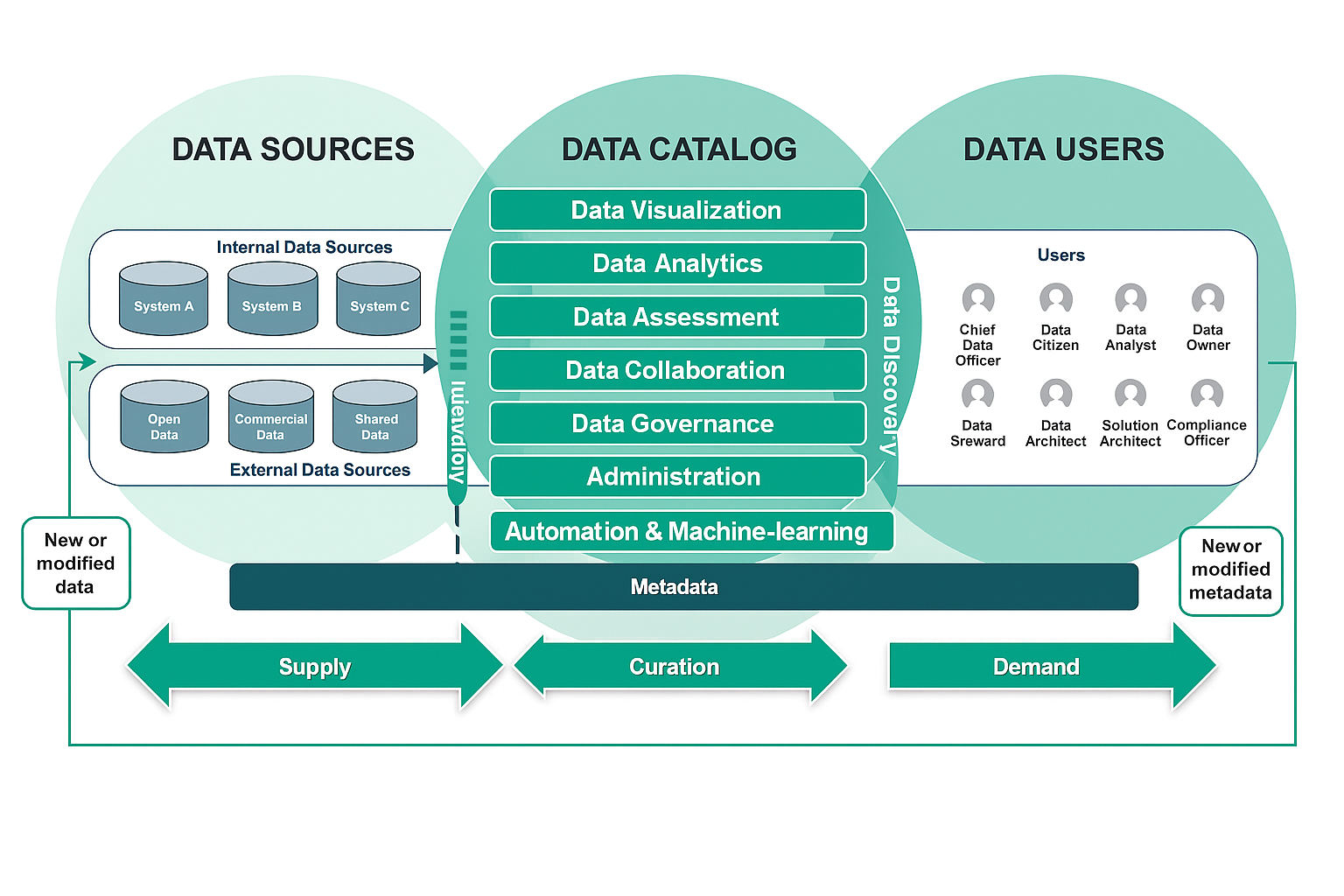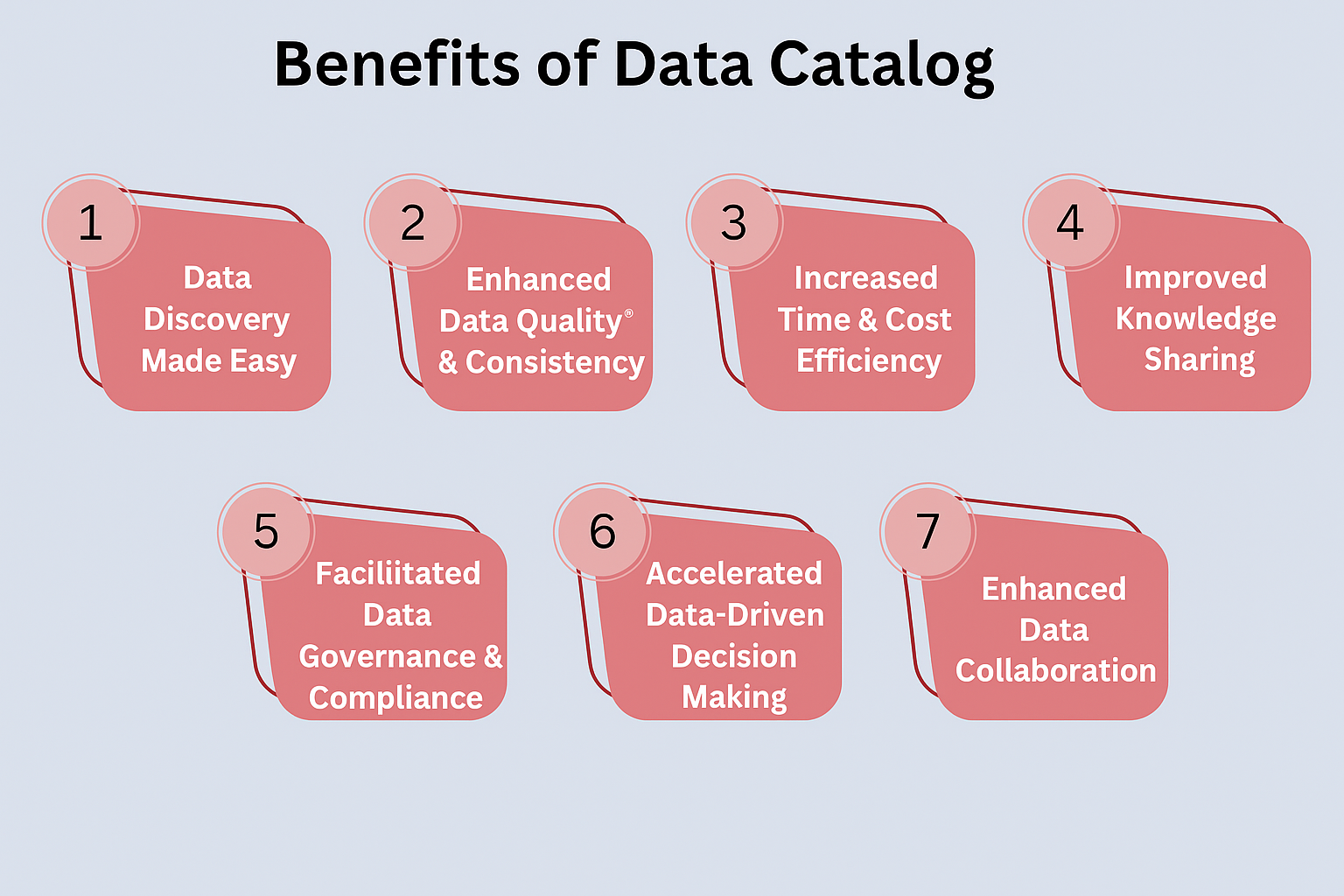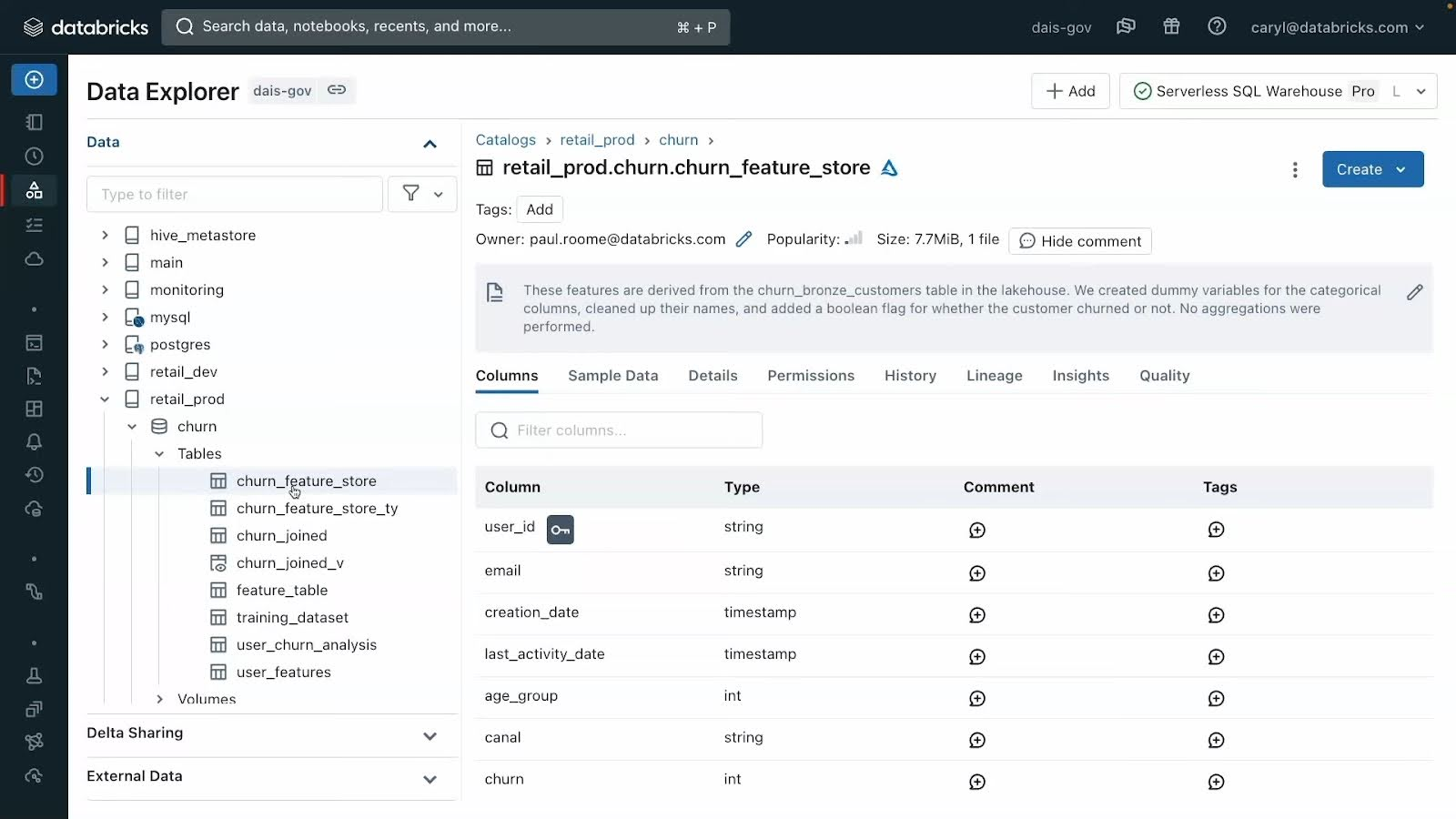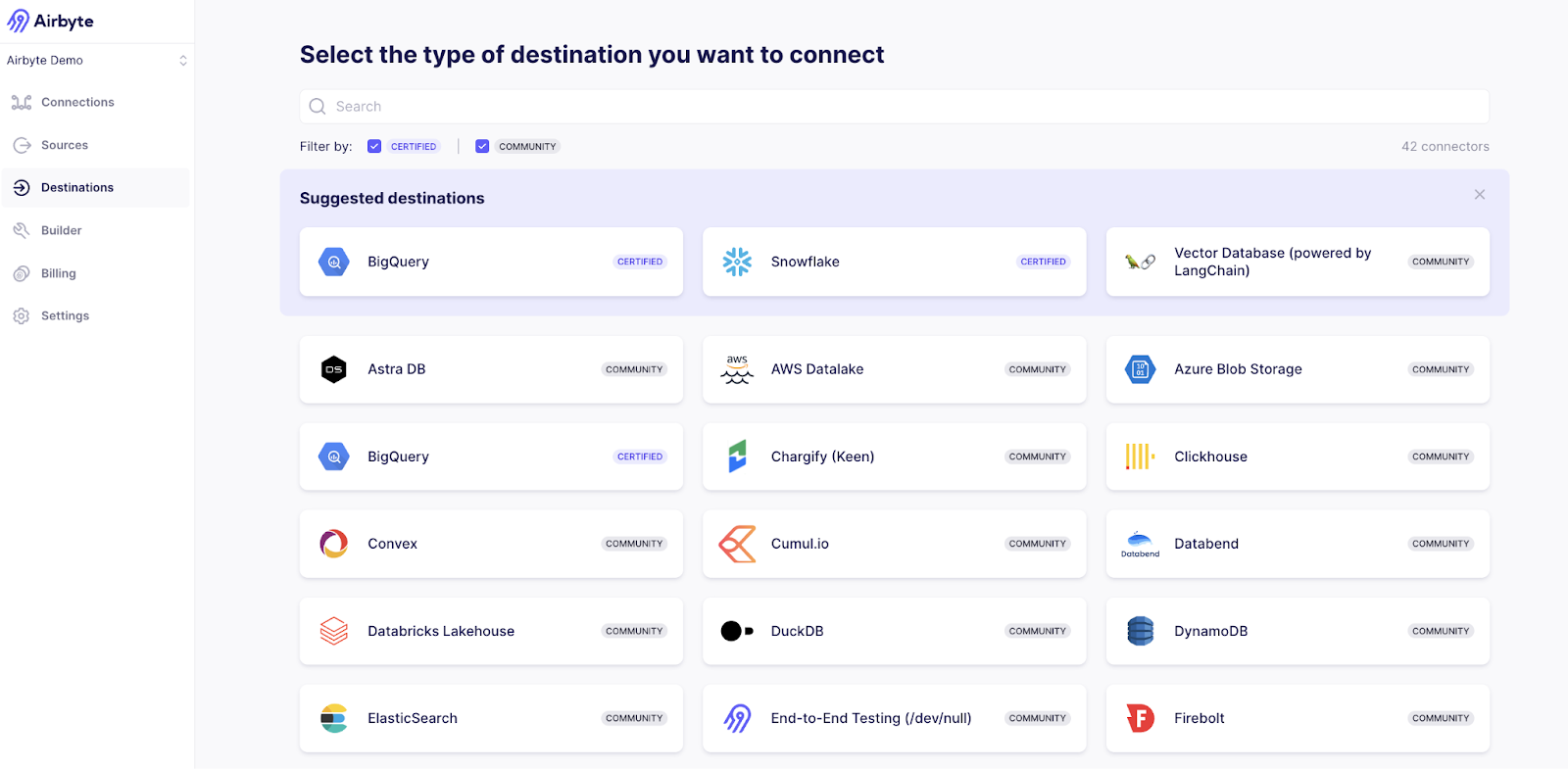What Is a Data Catalog? Explained With Examples
Summarize this article with:
✨ AI Generated Summary
Poor data quality costs organizations millions annually, largely due to inefficient data discovery across diverse systems. Implementing a comprehensive data catalog centralizes metadata management, enabling faster data discovery, improved quality, enhanced governance, and regulatory compliance.
- Key features include advanced search, integration with 600+ data sources, AI-driven automation, collaboration tools, and unified governance.
- Benefits include up to 60% reduction in data discovery time, improved data accuracy, enhanced security, and better cross-team collaboration.
- Emerging trends involve AI-powered metadata enrichment, autonomous governance, computational compliance, and knowledge graph integration.
- Solutions like Tableau Catalog and Databricks Unity Catalog exemplify modern capabilities, while Airbyte supports catalog accuracy through extensive data connectors and secure data movement.
Poor data quality costs organizations an average of $12.9 million annually, while data professionals spend up to 5 hours per week simply searching for the right datasets to analyze. This staggering inefficiency stems from a fundamental challenge: as enterprises accumulate vast amounts of data across diverse systems and formats, they often lack a unified way to discover, understand, and trust their information assets. The solution lies in implementing a comprehensive data catalog—a centralized system that transforms chaotic data landscapes into organized, discoverable, and trustworthy resources that drive meaningful business outcomes.
A data catalog serves as the cornerstone of modern data management strategy, providing organizations with the visibility and control needed to maximize their data investments. By creating a single source of truth for all data assets, enterprises can dramatically reduce discovery time, improve data quality, and ensure compliance with evolving regulatory requirements.
What Is a Data Catalog and Why Do Organizations Need It?
A data catalog is a centralized repository or tool that helps organize and manage an organization's metadata. It provides detailed information, including the data's structure, location, ownership, usage, and relationships with other data assets.
By providing such a comprehensive overview, data catalogs help you discover, understand, and trust the data available within your organization. Beyond data management, data catalogs also facilitate effective data governance, enhance collaboration among various stakeholders, and promote informed decision-making.

Recent market analysis indicates that the global data catalog market reached $1.38 billion in 2025, with projections suggesting growth to $9.22 billion by 2035, representing a compound annual growth rate of 23.1%. This impressive expansion underscores the critical role data catalogs play in empowering organizations to manage increasingly complex data environments while meeting stringent compliance requirements and delivering measurable business value.
What Are the Essential Features That Define an Effective Data Catalog?
Data catalogs offer a range of essential features to enhance organizational data management and utilization:
1. Search and Exploration
Advanced search and filtering capabilities allow you to efficiently locate datasets for analytics or engineering tasks. Modern catalogs incorporate natural language processing that interprets contextual queries, returning ranked results with relevance scoring based on usage patterns and data freshness. They also enhance retrieval of metadata-driven results, suggestions, and alerts based on user ratings and reviews.
2. Versatile Connection with Diverse Data Sources
A data catalog integrates with various data sources, serving as a comprehensive repository of an organization's data assets. Leading solutions now support over 600 pre-built connectors, spanning databases, APIs, SaaS applications, and cloud platforms. It maintains robust connections to existing assets and is continuously updated to support new data sources through automated discovery and cataloging processes.
3. Automation and Data Intelligence
By leveraging AI and ML, data catalogs automate routine data-management tasks and apply advanced analytics to metadata, uncovering valuable insights. Modern implementations include generative AI capabilities that automatically draft column descriptions, suggest business terms, and convert natural language queries into executable analysis workflows, reducing metadata creation time by up to 70%.
4. Tools for Collaboration
Built-in collaboration tools let stakeholders discuss, exchange information, and comment, review, or rate data assets. Contemporary platforms feature embedded workflows where business users can rate datasets, provide feedback on quality issues, and contribute crowdsourced documentation that improves overall metadata richness.
5. Unified Data Governance
Integrated governance tools manage data stewardship, quality control, and security, ensuring compliance with relevant policies and regulations. Advanced governance features include automated policy enforcement, real-time access control, and continuous compliance monitoring that adapts to evolving regulatory requirements like GDPR, CCPA, and emerging AI governance frameworks.
What Are the Key Benefits Organizations Gain from Implementing Data Catalogs?

Enhanced Data Analysis
Data catalogs simplify data discovery, enforce data-quality standards, and streamline data integration, enabling faster, more reliable analysis. Organizations implementing comprehensive catalogs report reducing their analytics cycle times by 50% while improving data accuracy through automated quality monitoring and lineage tracking.
Quick Data Discovery
Robust search functionality helps you find data quickly using tags, metadata, keywords, attributes, or filters, boosting productivity and supporting timely decisions. Advanced catalog implementations demonstrate that analysts can reduce their data discovery time from 5 hours per week to under 2 hours, representing a 60% efficiency improvement that translates directly to faster business insights.
Enhanced Data Security
Role-based access controls and detailed audit trails help manage sensitive data, maintain integrity, and ensure compliance. Modern catalogs provide automated sensitive data discovery, real-time policy enforcement, and comprehensive audit logging that meets requirements for SOC 2, HIPAA, and international privacy regulations while supporting data sovereignty initiatives.
Better Collaboration and Knowledge Exchange
A user-friendly interface lets teams share insights and documentation while ensuring everyone works with the most current data. Contemporary platforms enable cross-functional collaboration through integrated workflows that connect business context with technical metadata, improving data literacy across organizations and reducing miscommunication between technical and business teams.
How Can Organizations Successfully Implement a Data Catalog Strategy?
Step 1: Metadata Collection
Scan data repositories to identify datasets, tables, and files, then ingest their metadata into the catalog. Modern automated discovery tools can classify and profile data assets across cloud platforms, on-premises systems, and hybrid environments without manual intervention.
Step 2: Build a Data Dictionary
Document the collected metadata in a structured data dictionary via software tools or comprehensive documentation platforms. Contemporary approaches leverage AI-assisted generation to create initial metadata scaffolding that stewards can refine and enhance over time.
Step 3: Profile the Data
Run data-profiling jobs to visualize and understand dataset contents. Advanced profiling includes statistical analysis, quality scoring, and anomaly detection that provides insights into data distribution, completeness, and potential quality issues.
Step 4: Mark Relationships Among Data
Identify relationships among datasets to see how they connect. This includes mapping foreign key relationships, identifying common attributes across systems, and documenting business rules that govern data interactions throughout your organization.
Step 5: Build Data Lineage
Create visual data lineage diagrams to trace data flow from source to destination. Comprehensive lineage tracking enables impact analysis, supports regulatory compliance, and helps identify root causes when data quality issues arise in downstream systems.
Step 6: Organize the Data
Tag and categorize data so users can easily discover and trust it. Implement consistent taxonomies, business glossaries, and semantic relationships that reflect your organizational structure and business domains for intuitive navigation.
Step 7: Accessibility and Security
Ensure the catalog is easy to access within your data stack and enforces role-based security, auditing, and encryption. Integration with existing authentication systems and workflow tools ensures adoption while maintaining enterprise security standards.
How Do Organizations Measure and Demonstrate Data Catalog ROI?
Quantifying the business value of data catalog implementations requires structured measurement frameworks that capture both tangible cost savings and qualitative improvements in data operations. Organizations successful in demonstrating catalog ROI focus on three primary value streams: time savings, quality improvement, and compliance efficiency.
Establishing Baseline Metrics
Effective ROI measurement begins with capturing pre-implementation baselines across key performance indicators. Critical metrics include average time spent searching for data per analyst (typically 3-5 hours weekly), frequency of data quality incidents requiring rework, compliance audit preparation duration, and the percentage of data requests that remain unfulfilled due to discovery challenges. These baselines provide the foundation for measuring post-implementation improvements.
Time-to-Value Quantification
Data catalog implementations typically deliver measurable productivity gains within 60-90 days. Organizations report reducing data discovery time by 60% on average, which for a team of 50 analysts translates to approximately 150 hours of recovered productivity weekly. When valued at standard analyst hourly rates, this represents annual savings exceeding $400,000 for mid-sized analytics teams, not including downstream impacts on decision-making velocity.
Quality and Compliance Impact Measurement
Beyond direct time savings, successful catalog implementations reduce data quality incidents through proactive monitoring and lineage tracking. Organizations measure this through metrics like reduction in report errors, decreased time to resolve quality issues, and improved compliance audit scores. Financial services firms report reducing compliance preparation time from weeks to days, while healthcare organizations demonstrate improved patient data accuracy through automated governance workflows.
Attribution Modeling and Value Leakage Prevention
Advanced ROI frameworks incorporate attribution modeling that distinguishes catalog-driven improvements from concurrent initiatives. This includes tracking downstream impacts such as reduced report regeneration costs, improved customer experience scores from better data quality, and accelerated product development cycles enabled by faster data access. Organizations also monitor value leakage indicators that identify areas where catalog benefits may be undermined by incomplete adoption or process gaps.
What Emerging Trends Are Shaping the Future of Data Catalogs?
The data catalog landscape is experiencing rapid transformation driven by artificial intelligence integration, regulatory evolution, and changing organizational data architectures. Understanding these trends enables organizations to make informed technology investments and prepare for next-generation data management capabilities.
AI-Powered Active Metadata and Automation
Modern data catalogs are evolving beyond passive metadata repositories toward active intelligence platforms that continuously monitor, analyze, and act upon data environments. Generative AI now enables automatic metadata enrichment, where large language models draft contextually relevant dataset descriptions, suggest business terms, and identify potential quality issues without manual intervention. Leading organizations report 70% reduction in metadata creation overhead through AI-assisted documentation workflows.
Agentic AI and Autonomous Governance
The next evolution involves deploying specialized AI agents that autonomously manage governance tasks, from policy enforcement to quality remediation. These agents can set objectives, plan implementation approaches, and collaborate with human stewards to maintain data standards. Early implementations demonstrate 75% reduction in manual stewardship tasks while improving metadata accuracy to 98% compared to traditional human-only processes.
Regulatory Compliance and Computational Governance
Evolving regulations like the EU AI Act, updated PCI DSS 4.0 requirements, and proliferating state privacy laws are reshaping catalog capabilities. Modern implementations incorporate computational governance frameworks where policies execute automatically across platforms, ensuring GDPR compliance for European data subjects while applying different standards elsewhere. Organizations implementing these frameworks report reducing audit preparation time from weeks to hours while maintaining continuous compliance monitoring.
Knowledge Graphs and Semantic Relationships
Data catalogs increasingly incorporate knowledge graph capabilities that reveal contextual relationships traditional hierarchical structures miss. These implementations connect customer demographics to transaction patterns through shared attributes, enable complex regulatory impact analysis, and support advanced analytics use cases. Organizations leveraging knowledge graph capabilities report discovering previously unknown data relationships that drive new business insights and optimization opportunities.
What Are Leading Examples of Modern Data Catalog Solutions?
Data catalogs help organizations use accurate, timely data for analysis. Here are two leading examples:
1. Tableau Catalog

Lineage Graph – Visualize relationships between tables, databases, flows, columns, and workbooks, and alert users about changes.
External Assets Inventory – List databases, files, and tables with usage metrics to spot redundant data.
Data Quality Alerts – Flag data assets and propagate alerts to dependent content when sources are stale or under maintenance.
2. Databricks Unity Catalog

Open Data Sharing – Securely share data and AI resources across clouds without complex ETL or data replication.
Automated AI Monitoring – Track errors and send alerts to maintain model accuracy.
Consolidated View of Data and AI – Explore and manage data and AI assets in one place, regardless of cloud provider.
How Does Airbyte Enhance Your Data Catalog Implementation?

Airbyte streamlines data movement so your catalog always reflects the latest information. With over 600 connectors, Airbyte consolidates data from diverse sources into centralized locations for comprehensive cataloging and management.
Airbyte's open-source foundation eliminates the vendor lock-in that constrains many enterprises using legacy ETL platforms, while providing enterprise-grade security and governance capabilities essential for catalog implementation. The platform processes over 2 petabytes of data daily across customer deployments, ensuring reliable data movement that keeps catalog metadata current and accurate.
Key features that enhance catalog implementations include:
- Extensive Connector Library – Access 600+ pre-built connectors covering databases, APIs, SaaS applications, and cloud platforms for comprehensive data source coverage.
- Custom Connectors – Build your own via the no-code connector builder, low-code CDK, or language-specific SDKs for specialized catalog integration requirements.
- Change Data Capture (CDC) – Capture inserts, deletes, and updates at configurable sync intervals for full transparency in data lineage tracking.
- Open Standards Support – Generate portable code and metadata that integrates seamlessly with modern catalog platforms while avoiding proprietary lock-in.
- Enterprise Security – SOC 2, GDPR, and HIPAA compliance ensures catalog implementations meet regulatory requirements without compromising data protection.
Summing It Up
A data catalog is essential for modern data management, providing a centralized repository of metadata that enhances data visibility, access, and trust. It improves collaboration, supports governance, and empowers organizations to derive greater value from their data assets.
The evolution toward AI-powered active metadata, automated governance, and regulatory compliance capabilities positions data catalogs as strategic infrastructure rather than simple inventory tools. Organizations that invest in comprehensive catalog strategies today will be better positioned to leverage emerging technologies like generative AI while maintaining the governance and compliance standards essential for sustainable data operations.
FAQs
What does a good data catalog look like?
It is user-friendly, searchable, and offers comprehensive metadata with lineage, collaboration features, integration with diverse data sources, and robust governance and security.
Who uses a data catalog?
Data analysts, data scientists, business analysts, data stewards, IT administrators, product managers, and other stakeholders rely on data catalogs for discovery, governance, and decision-making.
What is the difference between a data catalog and a data lake?
A data catalog is an inventory that organizes and manages metadata, improving discovery and governance. A data lake is a storage repository that holds raw data. The catalog describes; the lake stores.

.webp)
.webp)